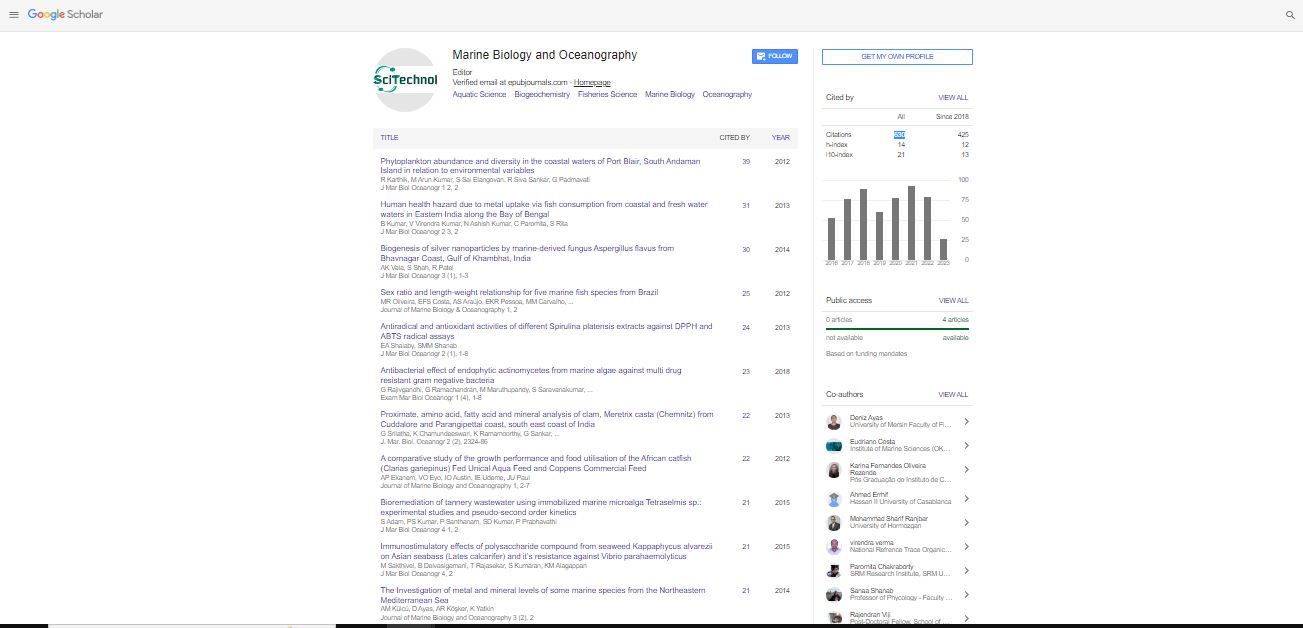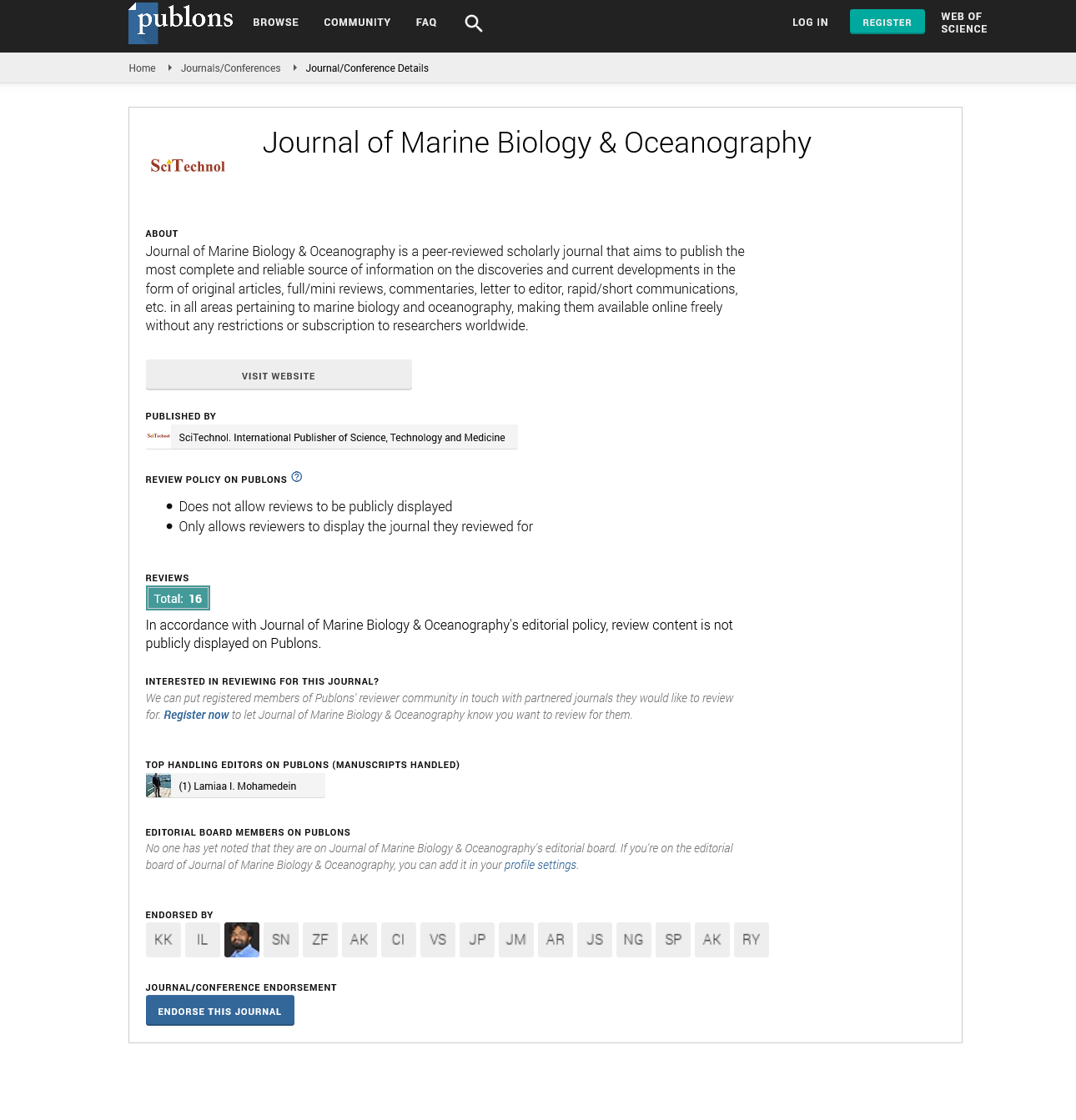Perspective, J Mar Biol Oceanogr Vol: 11 Issue: 2
Inactivation of Anisakis Larva Quality Evaluation Treated With Pulsed Power
John Miyake *
Fisheries Technology Institute, Japan Fisheries Research and Education Agency, Hatsukaichi, Hiroshima, Japan
*Corresponding author: John Miyake, Fisheries Technology Institute, Japan Fisheries Research and Education Agency, Hatsukaichi, Hiroshima, Japan, Email: miyakej56@gmail.com
Received date: 07 January, 2022, Manuscript No. JMBO-22-57171;
Editor assigned date: 10 January, 2022, Pre QC No. JMBO-22-57171 (PQ);
Reviewed date: 24 January, 2022, QC No JMBO-22-57171;
Revised date: 04 February, 2022, Manuscript No. JMBO-22-57171 (R);
Published date: 14 February, 2022, DOI:10.4172/jmbo.1000228
Keywords: Anisakis Larva
Description
Anisakis is a parasite that is found in many marine products and can cause anisaks when present in fish consumed raw. The most common way to prevent anisakis is to freeze the fish, but this causes a noticeable decrease in the quality of the fish when eaten as sashimi. Although no practical method of killing anisakis other than freezing has been found, we have now succeeded in inactivating anisakis inside the fish meat by repeatedly and instantaneously applying electric current to the fish meat using pulsed power technology. The fish meat was placed in buffer saltwater, and pulsed power was applied multiple times. The immobilization rate was highest when the buffer saltwater was 5 ms/cm. The immobility ratio increased as the number of shots increased. Sensory evaluation of the fish meat after the pulse treatment confirmed that it retained its quality as sashimi. Breaking tests and color measurements were also conducted. We believe that this pulsed power treatment is a useful alternative to freezing as a method for killing anisakis. An empirically estimated harvest function for an off-shore long line fishing vessel is integrated with a demand model for swordfish, and costs. This integrated model is used to examine the economic viability of the conventional pre-trip revenue share scheme between fishing vessel crews and owners, and then to explore optimal fishing efforts to maximize profits. The results demonstrate explicit outcomes of fishing efforts in economic benefits between rational fishing behavior based on the conventional revenue sharing scheme and optimum fishing efforts to maximize seasonal economic profit. This is due to the trade-off between the quality of landed fish and pursuing more fishing opportunities during a trip.
Effects of Total Ammonium Nitrogen
There is a discrepancy between a crew’s rational choice of fishing efforts to maximize their share per trip and the vessel owners’ preference to maximize seasonal profit. We propose that it is necessary to move from the conventional remuneration scheme to align economic incentives and maximize economic benefits for both vessel crews and owners. The effects of Total Ammonium Nitrogen (TAN) on hatching; metamorphosis and survival of the Geoduck clam Panopea japonica in early life stages (larvae and juvenile) were studied. Ammonia had a significant impact on the hatching ratio at different concentrations. The survival ratio of larvae and juveniles was reduced significantly along with increasing TAN concentration. The maximum acceptable toxicant concentration (MATC) of TAN for larval relative growth ratio was 0.49 mg/L (equivalent to 0.013 mg/L of un-ionized ammonia), and EC50 for survival after 192 h was 1.04 mg/L (equivalent to 0.028 mg/L of un-ionized ammonia). The MATC of TAN on the metamorphosis ratio of P. japonica was 0.93 mg/L (equivalent to 0.030 mg/L of un-ionized ammonia). In juveniles, there was no significant difference in survival ratios with TAN concentrations ranging from 4.07 to 7.01 mg/L. MATC for survival was 7.01 mg/L (equivalent to 0.22 mg/L of un-ionized ammonia), and the LC50 after 96 h was 13.96 mg/L (equivalent to 0.44 mg/L of un-ionized ammonia). Our findings provided information of the larval and juvenile P. japonica in response to the TAN stress. White trevally Pseudo caranx dentex is a high-value carangid fish species that is only cultured in Japan under full lifecycle aquaculture conditions. To make the reproductive process successful and efficient, sexual phenol typing of brood stock is essential, and this has conventionally been practiced via examination upon abdominal compression. However, in certain cases, sexual phenol typing is not successful due to unsuccessful sperm or semen collection, which leads to misclassification of the phenotype.
Male Characteristic DNA Sequence
This study identified the male characteristic DNA sequence of P. dentex. The pectoral fins of eight male and eight female 6-year-old F3 generation broods tock fish were utilized for male sex hormone quantification to determine each sex phenotype. The same fish DNA samples were subjected to bulked-Amplified Fragment Length Polymorphism (AFLP) screening, and a male characteristic AFLP DNA fragment of 227 bp in size was identified. A male characteristic fragment was also confirmed by second amplification when it was performed individually. All eight males used for screening carried the AFLP fragment, while none of the eight females did. AFLP was conducted for all 40 broods tock, and it was determined that all 24 putative males were AFLP positive, and 4 of the 16 putative females were AFLP positive. These results indicate that P. dentex may have a male characteristic DNA polymorphism. The nucleotide sequence of the male characteristic fragment showed high homology to Atlantic horse mackerel Trachurus trachurus chromosome 5, and the sequence did not have clear homology to known coding genes. Further studies are required to identify the sex-determining gene of P. dentex in the vicinity of the DNA sequence identified in this study. Accumulation of yolk precursor protein in the oviparous egg is essential for embryo growth. Transferrin-like protein, also known as major yolk protein, is a major precursor protein in sea urchins and sea cucumbers. In sea urchins, a new yolk protein was recently detected in strongly ocentrotus intermedius and Mesocentrotus nudus eggs. This protein, tentatively named Yolk-Related Protein (YRP), was thought to have important physiological functions for sea urchin gonadal growth and gametogenesis. To understand the relationship between YRP and vitellogenesis, we investigated the molecular structure of sea urchin YRP, quantified the transcript levels during oogenesis, and identified the presence of YRP in coelomic fluid. Using molecular cloning, we characterized one cDNA that encoded YRP (mn-yrp). Structural analysis revealed that mn-YRP is an apo lipoprotein B (ApoB)-like protein that belongs to the large lipid transfer protein superfamily. Quantification of mn-yrp (mn-apob) transcripts showed that mn-apob is mainly expressed in the stomach during gonadal growth. Immuno biochemical methods using antiserum revealed that mn-ApoB was present in the coelomic fluid. These results indicate that ApoB has a role in the transport of nutrients, such as sugar, lipids, and carotenoids, from the digestive tract to eggs via coelomic fluid in sea urchin. Most marine mollusks exhibit osmoregulatory mechanisms to cope with hypo- or hyperosmotic stress. In the present study, we elucidated the effects of exposure to hyposmotic and hyperosmotic stress on bay scallop Argopecten irradians. The Na+, K+, and Cl− ions of bay scallop hemo lymph traversed in a similar direction as that of surrounding salinity. Moreover, the gill Na+/K+-ATPase was affected by changes in salinity. We further evaluated the Heat Shock Protein (HSP) 70 mRNA expression in the digestive diverticula and glucose levels in the hemo lymph of bay scallops. Sudden changes in salinity were found to affect the HSP70 mRNA expression and glucose levels. In 55% salt water (SW) at 48–72 h, HSP70 mRNA expression and glucose levels were reduced compared to the control. HSP70 mRNA was present in the cells of digestive diverticula tissue at higher levels in 120% SW at 72 h than in the control. A TUNEL assay revealed that salinity changes increased cell apoptosis. Thus, exposure to 55% SW or more for more than 24 h may threaten the survival of marine mollusks. We examined the radiocesium concentration, age, standard length, and stomach contents of smallmouth bass Micropterus dolomieu collected from Lake Hayama, Fukushima Prefecture, Japan, in 2014. Across three seasons sampled, fish and aquatic insects were common foods for M. dolomieu; the most frequently occurring forage items were Osteichthyes. The mean radiocesium concentration in M. dolomieu muscle was 582 Bq kg–1 wet weights, and the concentrations in different categories of stomach contents ranged from 297 to 811 Bq kg–1 wet weight. Considering the radiocesium concentrations in the lake water and in plankton (which included some particulate organic matter), it was possible that M. dolomieu radiocesium contamination is mainly transferred via the food chain. A positive correlation existed between M. dolomieu standard length and radiocesium concentration. However, in M. dolomieu of the same size range, the concentrations did not differ significantly between fish that existed at the time of the Fukushima Daiichi Nuclear Power Plant accident and those born afterward. Although some fish sampled in 2014 were highly contaminated, the initial Fukushima fallout does not necessarily explain the high radiocesium concentrations in some M. dolomieu in the lake several years after the accident. The contamination levels observed in M. dolomieu might result from radiocesium concentrations in their available food at any time, whether immediately or several years after the Fukushima accident. In sea urchin hatcheries that produce seeds for the strongly ocentrotus intermedius stock enhancement program, promoting broods tock maturation is advantageous for early gamete collection and the resultant increase in seed size when they are released on fishery grounds. Here, the effects of photoperiod control were investigated to develop a method for promoting gonadal maturation.
 Spanish
Spanish  Chinese
Chinese  Russian
Russian  German
German  French
French  Japanese
Japanese  Portuguese
Portuguese  Hindi
Hindi 
